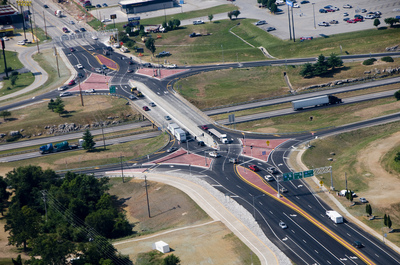Diverging Diamond
I read a neat article recently at work about a graduate student who came up with a new way of laying out a highway interchange. The problem with interchanges is the traffic that has to turn left to get onto ramps or the crossroad. Left turns make for conflict points for possible accidents and make traffic signals less efficient because only 1/4 of the traffic gets to move at one time. Also, since left-turning traffic backs up into traffic going straight, you put them in dedicated storage lanes. So a 4-lane road might have 4 through lanes and 2 left-turn lanes on the bridge adding expensive bridge square footage (about $100 per square foot). So what this guy did was said why not put an intersection at each end of the cross-road that shifts traffic to opposite sides of the road so that people actually drive on the wrong side of the road over the bridge? If you are on the left side of the road already, it is easy to turn left onto the ramp. And people coming off of the ramp who would be making a left could also make an easy left (if they are turning right they merge in on the other side of the intersection so it still works like an easy right). Anyway, this is called "diverging diamond" interchange as opposed to a regular old diamond interchange. The nice thing about it is that existing interchanges can be retrofitted to a diverging diamond. Another advantage is that by eliminating the need for left turn lanes, the bridge only has to carry two-way traffic, so it saves on the width of the bridge or lets you increase capacity of the interchange without widening the bridge and buying up the gas stations and restaurants that always show up on the corners.
After touting the interchange for several years with research spent on analyzing the design through traffic simulations, they found out that France already had a couple of these. But the first one in the US was just opened last year in Missouri and Georgia plans on doing several as well. You can click on the picture below for a bigger version. Notice from the crosswalks that pedestrians walk down the middle of the bridge.
Another similar concept, only without driving on the wrong side of the road, is a tear drop interchange where you put traffic circles (they are actually squished into tear drop shapes) on each end of the interchange. Here is an aerial view of one in Colorado. With traffic circles there are no left turns, everyone makes right turns. Another approach is to make the whole interchange a giant traffic circle: at the north end of the circle a bridge carries westbound traffic and the bridge on the south end carries eastbound traffic. You would need two (narrower) bridges this way but still avoid building left-turn lanes. Here is an aerial view of one in New York.

Comments (4)
The one I am working on starts construction in July!
Posted by Susan | May 7, 2010 10:33 AM
Amazing! It doesn't seem like that would work. I would think some people would panic thinking they were going the wrong way and then really go the wrong way.
Posted by Carol | May 10, 2010 8:01 PM
Which one is your favorite design?
As a non-expert with driving experience in the UK, the double teardrop seems a little less exotic than the diverging diamond, but maybe it's easier than it looks. ;)
Posted by Ed L. C. | May 15, 2010 1:53 PM
It seems like most of these designs aren't intended for real high traffic and congestion. The diverging diamond could work really well where commuters would be using it since they would get used to it after using it every day.
I didn't mind traffic circles when I was driving in Ireland and one good (or bad) thing about them is they force you to slow down no matter what road you enter on, so high-speed accidents are reduced.
I guess I might prefer the giant traffic circle since it requires twice as many bridges.
Posted by Ted | May 15, 2010 2:32 PM